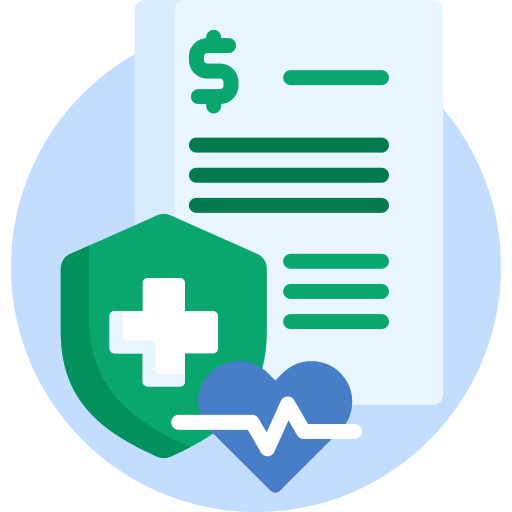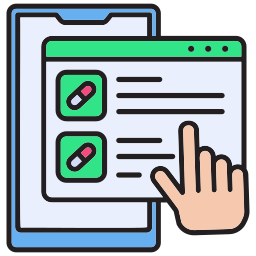EHR integration in the healthcare system refers to the seamless connection of EHR systems with other healthcare applications, databases, and workflows to ensure that patient data can be accessed, shared, and managed efficiently. EHR systems play an important role in improving the operations of healthcare facilities by consolidating patient records and enabling providers to deliver more personalized, data-driven care.
According to the Office of the National Coordinator for Health Information Technology (ONC), 96% of hospitals in the U.S. have adopted certified EHR systems, illustrating the growing importance of EHR integration in the healthcare system.
EHR integration in the healthcare system improves patient care by providing better access to patient records and ensuring continuity of care across different departments and facilities. It improves processes by automating data input and eliminating mistakes, allowing healthcare personnel to devote more time to patients than administrative activities.

1️⃣ Assess Your Current Systems and Requirements
Evaluate existing healthcare systems to ensure compatibility and identify needs for effective EHR integration. Dive into the intricacies of integrating EHR into the existing healthcare systems:
✅ Evaluate Existing Healthcare Systems
Start by carefully analyzing your existing healthcare systems. Identify these existing platforms and examine how they interact with each other. Ensure the system supports interoperability with an EHR system. This step helps determine the technical capabilities and identify potential gaps that could create integration challenges.
Related Read: Benefits of Interoperable Healthcare Data for Patients
✅ Review Software Compatibility
Check if the existing software can easily integrate with the new EHR system. Assess whether the software adheres to standard healthcare protocols like HL7 and FHIR. Compatibility ensures smooth data flow between systems, reducing the chances of disruptions during patient care or administrative tasks.
✅ Analyze Workflow Requirements
Assess your current workflows and identify areas where EHR integration can streamline processes. Consider clinical and administrative workflows to ensure the EHR system aligns with the needs of different departments. It eliminates unnecessary steps and improves overall operational efficiency.
✅ Identify Essential Features
List out the key features your organization needs from an EHR system. It may include real-time patient data access, billing automation, or secure communication channels. Focusing on essential features ensures the system addresses your specific requirements, ultimately improving the quality of care and operational flow.
✅ Pinpoint Gaps and Challenges
After evaluating the systems and workflows, identify any gaps that could hinder successful EHR integration. These might include outdated technology, insufficient staff training, or a lack of data security protocols. Addressing these gaps early on helps ensure a smoother integration process and reduces the risk of operational disruptions.
2️⃣ Data Migration and Interoperability
Data migration and interoperability ensure seamless integration and accurate healthcare information exchange across systems.
✅ Data Migration Challenges
During EHR integration in the healthcare system, data migration involves transferring large volumes of patient information from legacy systems to new platforms. This process is often complicated by inconsistent data formats, incomplete records, and potential data loss. Careful planning is essential to ensure all patient data is accurately transferred while minimizing disruptions in ongoing healthcare operations.
✅ Interoperability Between New and Legacy Systems
Ensuring interoperability between new EHR systems and older legacy systems is a significant challenge in EHR integration. Many legacy systems were not designed to communicate with modern platforms, making data sharing difficult. Healthcare providers need to implement standardized protocols, such as HL7 or FHIR, to facilitate smooth data exchange between systems, ensuring continuity of care.
✅ Maintaining Data Integrity
Data integrity is important during EHR integration in the healthcare system. Any errors or inaccuracies in the migrated data can lead to incorrect diagnoses, treatment delays, or compromised patient safety. To maintain data accuracy, healthcare organizations must conduct thorough testing, validation, and backup procedures throughout the migration process to ensure patient information remains complete and reliable.
3️⃣ Compliance with Healthcare Regulations in EHR Integration
Ensuring EHR integration complies with healthcare regulations is essential for protecting patient data privacy.
✅ Adherence to Local and Industry-Specific Regulations
Different countries and healthcare sectors may have unique regulatory requirements for EHR integration. Adhering to local laws, such as state-specific health regulations in the U.S., ensures that the healthcare system remains compliant. Organizations must stay informed about updates to industry-specific guidelines and adapt their systems accordingly to avoid legal penalties.
✅ HIPAA Compliance
EHR integration in the healthcare system must adhere to HIPAA regulations, which require strict regulations for patient data. Healthcare providers must ensure that electronic records are stored and transmitted securely, protecting sensitive patient information from unauthorized access. This includes implementing encryption, audit trails, and secure authentication measures to maintain confidentiality.
Related Read: How to Become HIPAA Compliant?
✅ GDPR Adherence
For healthcare systems dealing with patients in the EU, EHR integration must comply with GDPR. This regulation mandates patient consent for data usage and enforces strict data collection, processing, and storage guidelines. Healthcare organizations should ensure they provide patients access to their records while maintaining strict data protection standards.
✅ Patient Privacy
Privacy is a key concern in EHR integration, as patient data is susceptible. Healthcare providers must implement measures to protect personal health information (PHI) from data breaches. This includes multi-factor authentication, limiting access to authorized personnel only, and regular security audits to ensure the system meets current privacy standards.
✅ Data Security Protocols
EHR integration requires robust data security protocols to prevent cyber threats. Healthcare organizations must adopt encryption technologies and secure data storage solutions to protect records during transmission and storage. Regular vulnerability assessments and system monitoring are crucial in identifying potential risks and ensuring that security protocols are up-to-date.
Related Read: Securing Healthcare: The Critical Role of Data Security
4️⃣ Training and Support for EHR Integration in the Healthcare System
EHR integration requires effective training and support to ensure successful adoption and optimal use.
✅ Importance of Proper Training for EHR Adoption
Training healthcare staff is important for smooth EHR integration in the healthcare system. It ensures that employees understand the system’s functionalities and can use it effectively in their daily operations. Proper training reduces errors, improves efficiency, and helps staff adapt more quickly to new workflows.
✅ Structured Training Programs for Healthcare Professionals
Structured training programs should be designed based on the staff's roles, ensuring each team member learns the specific features they will use. Regular training sessions and practical demonstrations help staff familiarize themselves with the new EHR system and feel more confident in using it for patient care and data management.
✅ Providing Continuous Support for EHR Users
Continuous support is important after the EHR system is implemented. Providing accessible technical assistance, user guides, and troubleshooting helps staff resolve issues quickly. Support teams should be readily available to address any concerns, ensuring that the system operates smoothly without disruptions to patient care or administrative tasks.
✅ Ensuring Smooth User Adoption Through Feedback
Gathering feedback from healthcare staff during and after the EHR integration process ensures smooth user adoption. Understanding their challenges allows organizations to make necessary adjustments and improvements. Continuous communication between staff and the implementation team fosters collaboration and ensures that the EHR system is used effectively in daily operations.
✅ Adapting to Ongoing Updates and System Changes
As EHR systems evolve, healthcare staff must stay updated with new features and improvements. Regular refresher courses and update sessions help them stay current with the system's capabilities. This approach ensures that staff continues to work efficiently while making the most of the system’s ongoing developments.
How HealthConnect CoPilot Helps with EHR Integration?
Proper EHR integration in the healthcare system is essential for improving patient care and streamlining operations within healthcare organizations. When implemented effectively, EHR systems improve access to accurate patient data and increase operational efficiency by automating routine tasks, reducing errors, and ensuring better collaboration among healthcare teams. Over time, these benefits contribute to improved patient outcomes, cost savings, and compliance with regulatory requirements.
HealthConnect CoPilot plays a vital role in supporting EHR integration by providing reliable solutions for integrating renowned EHR systems such as Epic, Cerner, Medgen, and more. It simplifies the process of connecting multiple EHR systems, ensuring smooth data exchange across different platforms.
By offering advanced tools for managing complex data exchanges, authentication, and real-time data monitoring, we help healthcare providers achieve smoother workflows, better decision-making, and reliable access to critical patient information. Whether integrating with a large system like Epic or a specialized platform like Cerner, we ensure your organization can manage and maintain its EHR systems effectively.
- What are the key steps in EHR integration?
The primary steps include:
- Needs assessment
- Vendor selection
- Data migration
- Training and support
- Go-live and optimization
- How can I ensure data accuracy during EHR migration?
Implement data validation processes, conduct thorough data mapping, and test the migrated data for accuracy.
- What factors should I consider when selecting an EHR vendor?
Evaluate factors like cost, functionality, scalability, interoperability, and vendor support.
- How can I address potential challenges during EHR implementation?
Develop a comprehensive change management plan, provide adequate training, and have a robust support system in place.
- How can I measure the success of EHR integration?
Track key performance indicators such as improved efficiency, reduced errors, enhanced patient satisfaction, and increased revenue.

Pravin Uttarwar, CTO of Mindbowser
As the CTO of Mindbowser, a healthcare-focused software development company, I am dedicated to delivering cutting-edge digital solutions that transform patient care and operational efficiency. With over 16 years of experience and as an MIT alumnus, I specialize in healthcare interoperability, FHIR-compliant systems, and AI-powered platforms, crafting scalable products and architectures tailored to the unique needs of healthcare providers and enterprises.
I have spearheaded the development of over 100 products and platforms, guiding them from concept to full-fledged solutions. My expertise extends to scaling remote tech teams, driving EHR integrations, and building secure, cloud-native healthcare solutions. By shaping technology visions and roadmaps, I help clients achieve long-term growth and success in the rapidly evolving healthcare landscape.
HealthConnect CoPilot enabled us to access real-time patient health data through integration with Apple HealthKit, enhancing care delivery while maintaining HIPAA compliance. This led to personalized care and improved outcomes for patients.

AI-enhanced Obstetrics Clinical Decision Support Platform
HealthConnect CoPilot's integration with Epic's Hyperspace has transformed our workflow. Automated post-delivery examinations and HL7 protocol use ensure accurate updates to Epic. Their expertise empowers informed decision-making in childbirth

Top Provider for Customized Healthcare Solutions
HealthConnect CoPilot's helped us to integrate with leading tracking devices such as Apple Watches and Fitbit. This integration enables effortless syncing of health data, providing users with real-time insights displayed directly on our flagship products: smart mirrors and digital calendars.

A Provider of Customizable Display Solutions
Post a comment Cancel reply
Related Posts
Navigating the Future of Healthcare Integration with SMART on FHIR Apps
SMART on FHIR enables apps to plug directly into EHR systems like Epic EHR, Cerner…
TEFCA in Healthcare: A Complete Guide
Healthcare has long struggled with fragmented data systems. Patient records are often locked within isolated…
Model Context Protocol (MCP): Revolutionizing Healthcare Chatbots with FHIR Integration
Healthcare technology is experiencing a paradigm shift with the emergence of Anthropic’s Model Context Protocol…
Healthcare Integration: The Understanding & Its Impact in Healthcare
Healthcare integration refers to connecting various systems, applications, and data sources within the healthcare ecosystem…
Value-based Care vs Fee-for-Service
Healthcare payment systems can feel a bit like deciding between paying for each item on…
Integrating FHIR and Genomics: How AI is Shaping the Future of Medicine
AI is transforming the way medicine approaches personalized healthcare, particularly through genomics. By analyzing vast…









